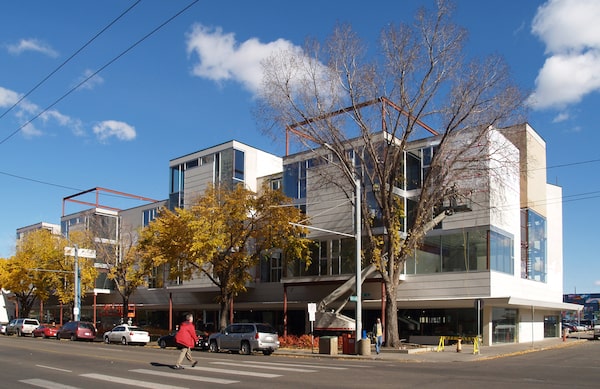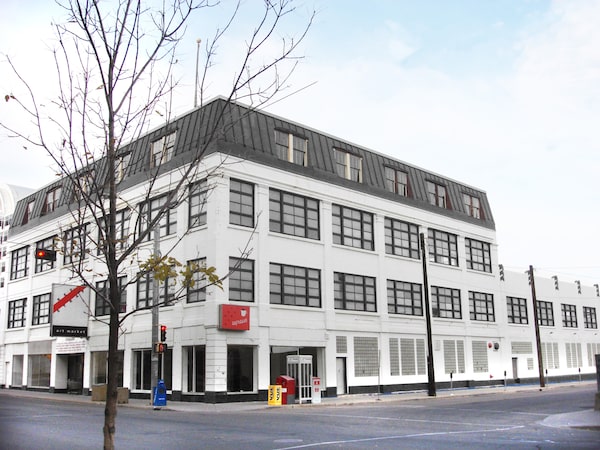Opening the Continental Treat Fine Bistro in the Quarters three years ago has had it challenges, says Edmonton-based restaurateur Sylvester Borówka, but the situation is getting better, as the city steps up police presence in the area.Amber Bracken
Once a thriving hub for business, Edmonton’s Quarters District is better known these days for vacant lots, empty storefronts and crime – a tough sell for revitalization efforts, say urban planners, landowners and commercial developers.
Breathing life back into the historic 40-hectare east-end neighbourhood will require property tax breaks, deep-pocket investment and wholesale rejuvenation of the entire downtown area, they say.
“It’s going to take a large development [to] change the character of the area or several projects in concert with each other,” says Gene Dub, founder and principal of Dub Architects Ltd. and a property owner in the Quarters through his real estate arm Five Oaks Inc.
Developers and city officials agree that attracting more people to the district is key to redevelopment. The Quarters Downtown Area Redevelopment Plan aims to boost its current population of 2,400 residents to 20,000 over the next 20 years.
Mr. Dub, who owns City Market Apartments on 97th Street, a 75-unit building that is fully occupied, says attracting families to the area as it is now is problematic.
With rents starting at $600 a month for a 570-square-foot studio, City Market has been attracting artists and creatives, which is slowly transforming the area into an arts hub.

Architect Gene Dub, who owns City Market Apartments in the Quarters, a 75-unit complex, says the building is currently fully occupied, but attracting families to the area as it is now is problematic.Dub Architects Ltd.
Attempts to house a daycare on the ground floor of the building and, later, a police recruitment centre both failed, Mr. Dub says.
“The ground floor has been empty for three years and we have not been able to lease it,” Mr. Dub says, adding that there are currently about a dozen empty storefronts on 97th Street.
In a recent setback, the Edmonton Downtown Farmers Market pulled out of the 60,000-square-foot Great Western Garment building, also on 97th Street, after association members voted to seek bankruptcy at the end of January.
“We had expected they would renew their lease for another five years,” Mr. Dub says. “That was a very big blow.”
Mr. Dub, who owns the GWG building, had invested $2-million into renovating the building in 2019 to accommodate market vendors prior to them moving.
At the time, the Quarters appeared to be on the cusp of redevelopment, with several construction projects in the works, including the striking 11-storey Hyatt Place Hotel (now a DoubleTree by Hilton) and Hat at Five Corners, a 25-storey apartment tower on Jasper Avenue.
The ingredients of urbanism that should and could make a great place [are] there.
— Kalen Anderson, CEO, Urban Development Institute, Edmonton Metro
Three historic brick buildings on Jasper were turned into offices and social-services space and the heritage Stovel Block, on 97th, was bought for redevelopment as transitional housing for homeless women with retail space planned for the main floor.
But the pandemic ground plans for further development to a halt. As stores and nearby offices emptied, the Quarters saw a rise in homelessness and crime.
Restaurateur Sylvester Borówka opened the Continental Treat Fine Bistro in the Quarters three years ago. Mr. Borówka, who still operates the original restaurant on Whyte Avenue, took a long-term lease at the city-owned heritage Goodridge Block on the corner of Jasper Avenue and 97th Street.
The first year in the Quarters was particularly difficult, with disturbances from street people, a break-in and vandalism, but the situation is getting better, he says, as the city steps up police presence in the area.

The Edmonton Downtown Farmers Market pulled out of the iconic GWG building on 97th Street in the Quarters in January.Dub Architects Ltd.
“We have done everything I can think of to make this area not only busy for us but more entertaining on the weekend,” he says. The business offers live music several nights a week and hosts corporate events.
“From our side, it’s too big an investment to walk away from, but it still has its challenges,” he says.
Since 2012, a City of Edmonton revitalization levy has funded $101-million in public infrastructure, including upgrades of drainage systems and improvements to city-owned buildings, Kinistinâw Park, and a central landscaped road and pedestrian corridor known as the Armiture, says David Holdsworth, senior planner, economic investment services at City of Edmonton.
Mr. Holdsworth says there are also plans in the works to change and simplify zoning to help spur growth, a process that could take about 18 months.
The city is in talks with non-profit and private groups about some city-owned vacant sites in the area, he says, adding that the planning department can sell to non-profits below market value in the area.
“We review what comes in and take what we think is the best long-term project that aligns with the Quarters’ vision,” he says.
He admits redeveloping the district is a long-term game but points out that “the potential in the area is phenomenal. It’s right downtown and right on the river valley edge.”
Kalen Anderson, chief executive officer of the Urban Development Institute, Edmonton Metro, agrees that plans for the Quarters look good on paper.
“The ingredients of urbanism that should and could make a great place [are] there.”
But she contends the rest of downtown, including the financial core, will need to solve its vacancy problem before the Quarters becomes attractive.
The Quarters can’t compete with other more amenity-rich neighbourhoods, such as Wîhkwêntôwin (formerly Oliver), west of the downtown, in attracting new tenants and crucial residential development, Ms. Anderson says.
Calgary, by comparison, has outpaced Edmonton in its efforts to rebuild the city centre and attract in-migration, Ms. Anderson says.
The city has also done a better job at revitalizing the East Village, an area that bears some similarities to the Quarters, and has created a municipal development corporation to take charge of development around the old Stampede grounds.
“[Calgary] realized quite quickly the urgency of the situation,” she says. “I think we’re in an urgent situation in Edmonton too but the sense of it doesn’t seem to be as well internalized.”